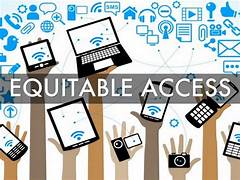AI in Ensuring Equitable Access to Technology
Artificial Intelligence (AI) has become one of the most transformative forces in the world today. From improving healthcare outcomes to enhancing productivity in various industries, AI promises to revolutionize every aspect of society. However, as with any technological advancement, AI brings with it the challenge of ensuring that its benefits are accessible to all, regardless of socioeconomic status, geographic location, or other barriers. The issue of equitable access to technology is one that is gaining increasing attention as AI continues to grow in importance.
In this article, we will explore how AI can play a crucial role in ensuring equitable access to technology, the barriers that prevent equal access, and how policymakers, developers, and communities can work together to create a more inclusive future.
The Importance of Equitable Access to Technology
Access to technology is no longer a luxury; it is essential for participating in modern society. In education, healthcare, finance, and employment, technology is the foundation upon which individuals can build successful lives. However, not everyone has equal access to these opportunities, and the digital divide has only widened with the rise of advanced technologies like AI.
Equitable access to technology ensures that everyone, regardless of their background, has the opportunity to benefit from the advancements of the digital age. In the case of AI, equitable access is critical for enabling communities to tap into its potential, whether for improving public services, enhancing job opportunities, or fostering innovation in education and healthcare.
The Barriers to Equitable Access to AI
While AI holds immense potential to improve lives, the unequal distribution of technology and digital literacy remains a significant barrier. Several factors contribute to the digital divide, including economic disparities, geographic limitations, lack of infrastructure, and insufficient education and training.
1. Economic Disparities
One of the biggest barriers to equitable access to AI technology is economic disparity. In many low-income communities, access to the necessary hardware and infrastructure for AI adoption—such as computers, high-speed internet, and AI software—is limited. Even if the technology is available, the cost of acquiring it can be prohibitively high for many families and organizations.
Furthermore, AI development is often concentrated in high-income countries and industries, where research and development funding is more readily available. This leaves underdeveloped regions and marginalized communities at a disadvantage, both in terms of accessing AI-driven services and in participating in the creation of AI technologies.
2. Geographic Limitations
Geographic factors also contribute to the inequality of access. Rural and remote communities often lack the necessary infrastructure to support AI technologies. High-speed internet, a critical component for accessing cloud-based AI systems, is not available in many rural areas, further exacerbating the divide between urban and rural populations. These geographical disparities create an environment where some people are unable to access the full benefits of AI due to their physical location.
3. Digital Literacy and Skills Gap
Even when individuals have access to the hardware and infrastructure, they may still face significant challenges in understanding and using AI tools. A lack of digital literacy, particularly in marginalized communities, prevents individuals from engaging with AI in meaningful ways. For example, individuals without knowledge of how AI systems work or how to use AI-powered applications may miss out on the opportunities that these technologies provide.
Moreover, there is a growing need for a skilled workforce capable of developing, implementing, and managing AI systems. Without proper education and training programs, many individuals will be excluded from high-demand AI-related jobs, reinforcing economic inequality and limiting access to the opportunities that AI can provide.
How AI Can Help Ensure Equitable Access to Technology
While AI can perpetuate inequality if left unchecked, it also has the potential to be a powerful tool for addressing these challenges. By leveraging AI to improve accessibility, promote inclusivity, and support education and job training, we can create a more equitable technological landscape.
1. Bridging the Digital Divide
One of the most important ways AI can ensure equitable access to technology is by helping bridge the digital divide. AI-powered solutions can be used to extend internet access to underserved regions, especially in rural and remote areas. For example, AI-driven satellite technology is already being used to deliver internet access to isolated communities around the world. Companies like SpaceX’s Starlink and OneWeb are using AI to deploy low Earth orbit (LEO) satellites that can provide high-speed internet in areas where traditional infrastructure is too costly or impractical to implement.
Moreover, AI can optimize the allocation of resources to enhance the effectiveness of these initiatives, ensuring that internet connectivity and access to AI-powered technologies are distributed in the most equitable manner possible.
2. Personalized Education and Training
AI has the potential to revolutionize education by providing personalized learning experiences for students of all backgrounds. AI-powered educational platforms can tailor content to meet the specific needs of each learner, adapting lessons to their pace, learning style, and proficiency level. This personalization ensures that students in underserved communities or those with learning disabilities can benefit from an education that is designed to address their individual challenges.
In addition to personalized learning, AI can play a crucial role in closing the skills gap by offering affordable, accessible, and scalable training programs. AI-powered platforms can provide remote learning opportunities for individuals in low-income areas, giving them access to high-quality courses in fields like computer science, engineering, and data science. These programs can help individuals acquire the skills necessary to participate in the AI-driven economy, boosting employability and economic mobility.
3. Inclusive AI Design and Development
Another critical way AI can ensure equitable access to technology is through inclusive design and development. Historically, the development of AI has been dominated by large corporations and research institutions in high-income countries. This lack of diversity in the field has led to AI systems that may not account for the needs and challenges of marginalized communities.
To address this, AI systems should be designed with input from a diverse group of people, including those from underrepresented groups. AI developers can work closely with community leaders, educators, healthcare providers, and other stakeholders to ensure that the AI systems they create are designed to be inclusive and address the needs of all people, regardless of their background.
Inclusive AI design also involves creating tools that are accessible to people with disabilities. For instance, AI-powered speech recognition can be used to assist individuals with visual impairments, and natural language processing (NLP) tools can be developed to support people with cognitive disabilities. By designing AI with accessibility in mind, developers can ensure that these technologies serve everyone, not just those who have the means to access them.
4. AI for Social Good
AI can also be used to address pressing social challenges, such as healthcare disparities, environmental issues, and food insecurity. By using AI to tackle these issues, we can create more equitable outcomes for underserved populations.
For example, AI-powered healthcare applications can assist in diagnosing medical conditions, predicting disease outbreaks, and improving access to care in underserved regions. In agriculture, AI can optimize farming practices and supply chain management, ensuring that food reaches populations in need. These applications of AI not only improve the quality of life for disadvantaged communities but also ensure that technological advancements benefit everyone.
Policy and Governance for Equitable Access
For AI to truly foster equitable access to technology, strong policies and governance frameworks must be put in place. Governments, businesses, and civil society must collaborate to ensure that AI is developed and deployed in ways that are inclusive, transparent, and fair. This includes establishing regulations that promote equitable access to technology, as well as creating systems for monitoring and addressing potential biases in AI systems.
Policymakers should also focus on funding and supporting initiatives that aim to close the digital divide and ensure that marginalized communities are not left behind in the AI revolution. This includes investing in digital infrastructure, promoting digital literacy programs, and ensuring that all individuals have access to the skills they need to thrive in an AI-driven world.
Conclusion
AI has the potential to be a great equalizer, offering unprecedented opportunities for people around the world to access technology, education, and employment. However, realizing this potential requires deliberate action to address the barriers that prevent equitable access to AI. By leveraging AI to bridge the digital divide, providing personalized education and training, promoting inclusive design, and using AI for social good, we can ensure that the benefits of AI are shared by all, not just a privileged few.
Policymakers, businesses, and developers must work together to create an inclusive and accessible AI ecosystem. Only through concerted effort and ethical considerations can we ensure that AI serves as a tool for progress, empowerment, and equality, benefiting individuals and communities across the globe. Equitable access to AI is not just an ideal—it is a necessity for creating a fairer and more just society.


